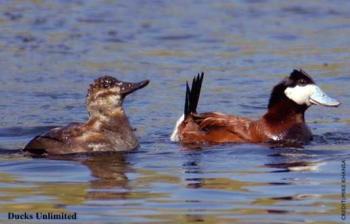 SKC Films Library SKC Films Library |
| |
| SKC Films Library >> Science >> Zoology >> Birds >> Order Anseriformes |
| Ruddy Duck Oxyura jamaicensis Description A male ruddy duck is about 5½ to 6 inches long and weighs about 1.3 pounds; the female is slightly smaller. Both sexes are similarly colored in the winter -- gray/brown with white breasts and bellies. In the spring, the male sports a red-brown chest, rump and flank, and a white streak on the cheeks. Characteristics of the species include large gray feet and a concave bill, which is gray is the winter but will change to a blue-gray in the spring for males. female (left) and male (right) ruddy ducks Distribution and Habitat The ruddy duck ranges throughout much of the United States, as well as north into Canada and south into central Mexico. It has also been introduced into Great Britain. It can be found just about anywhere there is open water (fresh or alkaline) and cover for protection during nesting. Reproduction Mating begins with an elaborate display by the male in front of the female. The male swims by the female several times with his tail raised in a fan, and then slaps his bill against his chest to produce a drumming sound and create bubbles from beneath his chest. The display appears to have more to do with territory declaration than courtship, however, since the female rarely pays much attention. The male may mate with more than one female, but will almost always return to swim with the young of the first mate after they hatch. Nesting begins in late May and peaks in the beginning of June. The nest is built gradually from grass as the number of eggs increases. On average, a female will lay one egg a day, with anywhere from 5 to 15 eggs being laid per clutch. Incubation last about 25 days, and chicks fledge at about 60 days of age. Ruddy ducks become sexually mature at about one year. Diet Ruddy ducks are primarily herbivorous but they will also eat animals. The diet includes pondweeds, stems and leaves, as well as insect larvae. Food is acquired by surface dives. Habits and Behaviors The migration period for ruddy ducks living in the northern portions of the species range generally begins in September and lasts until the end of October. The ducks usually migrate at night and typically move in flocks that can number into the hundreds. Migration back north begins in February and continues into April. Ruddy ducks are generally nocturnal. Ruddy ducks are poor fliers and require long "runways" to get airborne, so their best defense against danger is to either swim or dive. Scientific Classification phylum Chordata WEB SOURCE |
| SKC Films Library
>> Science
>> Zoology >> Birds >> Order Anseriformes This page was last updated on April 13, 2017. |
